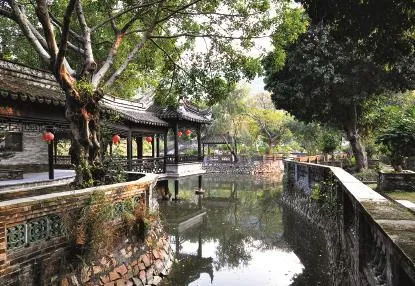中山
——依水发生
中山
——依水发生
中山旧称香山,北宋地理学家乐史所著《太平寰宇记》有载:“香山在县南,隔海三百里,地多神仙花卉,故曰香山。”
Zhongshan once went by the name of Xiangshan, or Heungsan (Chinese:香山; literally: "Fragrant Mountain"), in reference to the many fl owers that grew in the mountains nearby. This was recorded in a book titled Tai Ping Huan Yu Ji by a famous geographer of the Northern Song Dynasty.

Sanxiang town Yagang parades, Zhongshan, Guangdong.中山三乡鸦岗飘色巡游。

The Changjiang Reservoir, also called Qingning Lake, is one of the well-known tourist attraction in Zhongshan.坐落于五桂山麓的长江水库沿岸风光优美,是中山著名的旅游度假地。(龙春生/摄)
Zhongshan, a city of south-central Guangdong Province, is located along the west side of the mouth of the Pearl River. As it was recorded, thousands of years ago, Zhongshan, or Xiangshan as it was once called, was only a small island scattered within the Pearl River estuary, also called Lingdingyang. Gradually from south to north, the area was fi lled in with alluvial silt and became dry land. To some extent, this place was born by the water.
Being called “a Lingnan-style water village”, Zhongshan witnessed its development become integrated with the Pearl River and its tributaries. In the farming age, variegated rivers here brought convenience to farmers for agricultural irrigation and also saved time for travellers using the waterway.
During Jiaqing ( the seventh emperor) and Daoguang ( the eighth emperor ) Period of Qing Dynasty, a sustainable amount of immigrants from Central China drifted down the river, bringing optimized technologies to help elevate the development of this area and to help boost the agricultural and fi shing economy. Coincidently, they ushered in the fi rst economic boom here.
This may be one important reason why Shagang Market in Xiaolan Town, an old market in Zhongshan, maintained its status for hundreds of years until now. On the 3rd, 6th and 9th day of every lunar month, the market will still be jam-packed with people.
When leaving the prosperous commercial towns for rural areas, you will experience the residents' longkept habit of living near the river. Many houses by the water also feature a small dock or just stairs for people to board a ship.
This may be partly infl uenced by the water culture of Danjia people, a group that is sometimes referred to as “water gipsies” with their lives and traditions relying heavily on fi shing and other water-related activities. But more people see it as evidence of local people attaching great importance to the effi ciency of water transportation.
Chinese people believe that a person's character is partly infl uenced by the place where they live. In Northern China where there are mountainous regions, people are more straightforward, compared with the acute southerners who live in these marshy areas.
The growing population not only benefi ted for agriculture, but also for commerce and trade development. Through the extensive waterways found in this region, farmers in these rural areas were able to effectively and effi ciently transport surplus agricultural products to the city's market to sell.
Zhongshan, is one representative of this. Coupling with its development of trade and commerce, Zhongshaners enjoy a unique, adventurous nature, daring to explore and innovate.
Sun Yet-Sen, born in Tsuiheng Village, has been named the forerunner of China's democratic revolution. Later on it emerged that a lot of important fi gures from Zhongshan have infl uenced the history of China. For instance, Zhongshan-born Zheng Zaoru was the fi rst Chinese ambassador to hold positions in foreign countries. Yang Xianyi was thought to be the father of the Chinese Air Force. Kwok Lok and his brother founded the Wing On Department Store, one of the largest and bestknown retailers in Hong Kong.
Great changes have taken place in Zhongshan during the process of China's urbanisation, while many other villages quietly drifted out of existence. However, customs and rituals here have sunken deep in people's daily life.
People in Xiaolan Town have kept their practice of fl ower cultivation, especially chrysanthemums, for several hundred years and have gained an international reputation due to their efforts. A special kind of folk music is also still being sung today among generations in Minzhong Town. And fi nally, on the 6th day of the 5th lunar month, villagers in Nanlang Town hold a special ritual to celebrate the birthday of the Dragon King just as it was before.
Now, due to its location of neighbouring Macao and facing Shenzhen and Hong Kong across the bay, Zhongshan is a key city in the Guangdong-Hong Kong-Macao Greater Bay Area. As to how this livable city will develop, people are expecting it to integrate traditional water town culture with aspects of modern civilisation and gracefully move forward into the future.

Zhanyuan Garden, Zhongshan.极富水乡特色的广东中山瞻园。
中山号称“岭南水乡”,其发展离不开珠江水的滋润。农耕时代,广布的河涌水网不仅给农业灌溉带来了便利,更为旅人节省了时间。清朝嘉庆、道光年间,大量来自中原的移民,便是乘坐船只,顺流而下来到这里,为这个原本以半农半渔为主要经济模式的地区带来了比较先进的生产技术,同时带来了最初的繁荣。
人口的增多不仅利于农业,更促进了商贸的发展。利用四通八达的水道,即使是居住在郊区的农民,也可以迅速且大量地将盈余的农副产品运送到墟市中出售,从而铸就了小榄镇沙岗墟的百年兴旺,一直延宕至今,每逢农历三、六、九日,就会出现人潮汹涌,接踵摩肩的盛况。如果离开繁华的商业市镇进入中山的农业镇区,你就会发现,这里的居民现在仍然保持着靠水而居的习惯。很多水边的住宅都设有微型码头,至少是方便上下船的石阶,这里面有着部分疍家人水上文化的影响,但更多的人还是看重水上交通的便利。
中国有句俗语:“近水者智,近山者仁”。意思是说中国的北方人多近山,厚道粗犷。南方人多近水,聪慧精明。中山深得其妙。加上从古至今贯穿于民众生活之中的商贸传统,便造就出中山灵活求变,敢于创新的人文底蕴。“敢为天下先”的中国民主革命先行者孙中山先生,便是出生成长于坐拥山水,钟灵毓秀的中山翠亨村。其后中山还涌现出大批在中国历史上具有开创性地位的人物,如中国第一位驻外大使郑藻如、中国空军之父杨仙逸、中国百货业先驱,永安百货创始人郭乐等等。
在中国的城市化浪潮中,中山也正在发生翻天覆地的变化,许多自然村都已不复存在,但众多传统习俗却因为早已深入到当地人日常生活而依旧得到相当完整的保存。
现如今,中山又因其毗邻澳门,与深圳、香港隔海相望的优越地理位置,成为了“粤港澳大湾区”的重要组成部分。这座善于将传统水乡文化引入到现代生活中的宜居城市,在接受时代赋予的最新使命之后,又将发生什么样的变化?让人期待。
ZHONGSHAN BLOOMING BY THE WATER
Text by Liang Jianfeng, Yan Junling & Peng Xianting
Translation by Hu Nan, Bian Jiajin Photos by CFP, Zhongshan Tourism Bureau

